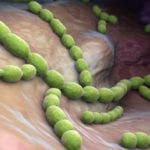 Creepy
Creepy  Creepy
Creepy  Movies and TV
Movies and TV 10 Movies That Get Elite Jobs Right, According to Experts
 Weird Stuff
Weird Stuff 10 Times Real Laws Were Based on Bizarre Hypotheticals
 Animals
Animals 10 Inspiring Tales of Horses Being Human
 Mysteries
Mysteries Top 10 Haunting Facts About the Ghost Ship MV Alta
 History
History 10 Surprising Stories About the Texas Rangers
 Humans
Humans 10 Philosophers Who Were Driven Mad by Their Own Theories
 Miscellaneous
Miscellaneous 10 Video-Game-Worthy Weapons and Armors from History
 Weird Stuff
Weird Stuff 10 Psychics Who Accurately Predicted Wartime Events
 The Arts
The Arts 10 Pieces of Art Inspired by a Broken Heart
 Creepy
Creepy 10 Death Superstitions That Will Give You the Creeps
 Movies and TV
Movies and TV 10 Movies That Get Elite Jobs Right, According to Experts
 Weird Stuff
Weird Stuff 10 Times Real Laws Were Based on Bizarre Hypotheticals
Who's Behind Listverse?

Jamie Frater
Head Editor
Jamie founded Listverse due to an insatiable desire to share fascinating, obscure, and bizarre facts. He has been a guest speaker on numerous national radio and television stations and is a five time published author.
More About Us Animals
Animals 10 Inspiring Tales of Horses Being Human
 Mysteries
Mysteries Top 10 Haunting Facts About the Ghost Ship MV Alta
 History
History 10 Surprising Stories About the Texas Rangers
 Humans
Humans 10 Philosophers Who Were Driven Mad by Their Own Theories
 Miscellaneous
Miscellaneous 10 Video-Game-Worthy Weapons and Armors from History
 Weird Stuff
Weird Stuff 10 Psychics Who Accurately Predicted Wartime Events
 The Arts
The Arts 10 Pieces of Art Inspired by a Broken Heart
10 Animals That Can Detect What Humans Can’t
Animals have always been superior to human beings when it comes to basic senses like hearing, sight, and smell. That is why we have spent centuries trying to learn from their abilities and put them to good use.
For example, we have yet to understand how so many wild creatures can predict earthquakes in advance by days and even weeks. Current information about their abilities is mostly speculation, but it’s certainly no coincidence when toads abandon their ponds days before an earthquake. Reportedly, even snakes have been spotted waking up from hibernation in the middle of winter and venturing out in deadly temperatures an entire month before an earthquake strikes.
Scientists hope to gather more insight by monitoring the behavior of such animals. But for now, earthquakes are still one of the natural disasters that are hardest to detect ahead of time. At least for human beings.
10 Birds

Many bird species, especially in the northern hemisphere, migrate when winter rolls around and food becomes scarce. Some even manage to fly thousands of miles away from their breeding grounds but return when the climate becomes warmer. An impossible task for anyone without a large cartography book or the Global Positioning System. Birds accomplish this incredible feat by detecting magnetic fields and using them for navigation.
After being baffled by this biological compass for several years, scientists figured out that birds can sense the strength and direction of magnetic fields. Evidence suggested that cells capable of picking up this information were located in the bird’s inner ear.
This was further backed up by the discovery of small iron “balls” within brains of all bird species surveyed so far. Hair cells that play an important role in movement and acceleration were confirmed to contain these iron-rich sensory neurons.[1] Despite the important discovery, this piece of the puzzle does not fully explain the superb navigational skills that birds possess.
9 Dolphins

These aquatic mammals are known for their ability to emit sound waves and detect information by interpreting the returning echo. These waves of sound are emitted by an organ in their heads, which works like radar. The main purpose of this ability is to inform dolphins about surrounding threats and prey, but it can even be used to detect pregnancies.
According to experts, echolocation may allow dolphins to detect a pregnant woman’s developing fetus. Doctors use high-pitched sound pulses, which are commonly known as ultrasound, to visualize fetal development. These sound waves are partly reflected at the boundary between muscle and skin tissues. Many reflection readings can be combined by a computer to produce a detailed image.
Dolphins create similar ultrasound waves and have been reported to take a special interest in pregnant women. When dolphins stimulate one another or hone in on something, they put their snout against the skin and “buzz.” This is a form of highly concentrated echolocation. Buzzing has also been noticed around the bellies of pregnant women.[2]
8 Rats
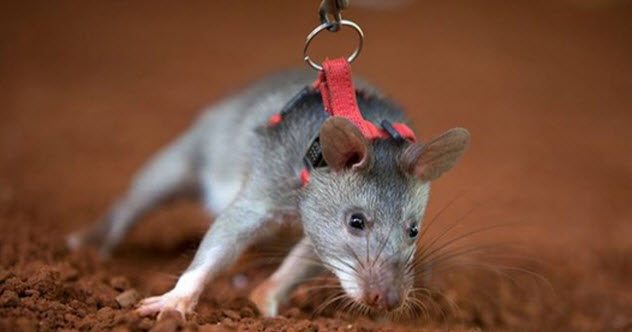
Even though many people act as though rats were land mines themselves, some of these animals have been trained to detect actual landmines since 1997. Specifically, the African giant pouched rats. These large rodents have poor vision, which is redeemed by an incredible sense of smell.
Over the years, they have sniffed out 13,200 mines in Angola, Tanzania, Mozambique, and Cambodia. Cambodia still suffers from an estimated six million land mines scattered around the country. Access to valuable land necessary for farming and building is cut off by this constant threat.
After nine months of training, the rats are capable of covering far more ground than humans, searching over 185 square meters (2,000 ft2) in 20 minutes. The same task takes people up to four days since they risk life and limb. It is necessary for humans to stop after every ping on the metal detector and ensure that the area is clear.
The rats, however, are not heavy enough to trigger the explosives and stop to scratch the ground whenever the source of TNT scent is reached. Land mines found in the marked areas are detonated later.[3]
7 Honeybees
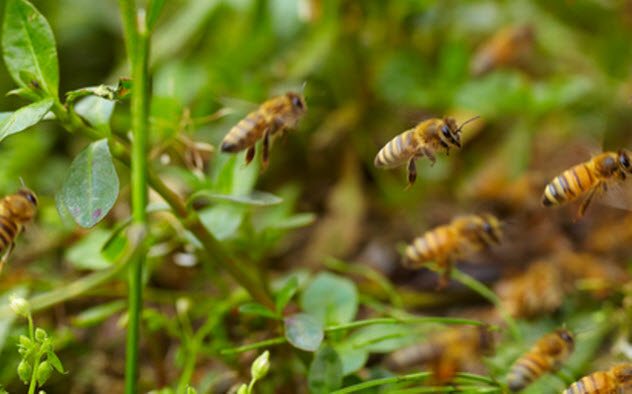
Besides the obvious answer of nectar, what could a honeybee possibly detect? Turns out, honeybees can be trained to find land mines by associating the smell of sugar with explosives.
These bees can detect the scent of TNT from 4.5 kilometers (2.8 mi) away. Thermal cameras are used to track their movements. Research continues, but honeybees are expected to be used on de-mined fields to check for any mines left behind.[4]
The advantage of using honeybees for this purpose is a lower cost than rats and dogs. Honeybees also recruit and teach other bees to do the same naturally by themselves. Their hairs can gather particles easily, detecting chemical vapor concentrations as parts per billion and very low parts per trillion.
Honeybees even hold the Guinness World Record for the smallest animal used in detecting landmines.
6 Cats

Cat owners have been reporting that their pets have healing powers for ages. While cats do not have the ability to cure sickness, they are definitely capable of detecting it.
Diseases cause chemical changes in the body, and cats use their acute sense of smell to identify whether someone is sick or not. Our feline friends gather more information by sensing changes in our mood and behavior. They can also detect illness in other animals.
One cat has even “predicted” 25 deaths in a nursing home. Although unfriendly by nature, Oscar the cat displayed sudden affection toward multiple residents who were close to death.[5]
Experts hypothesize that the cat can smell and sense organs shutting down. Do not hurry to schedule a doctor’s appointment if your cat suddenly sits in your lap, though. Even the most independent and egoistic beings want affection occasionally.
5 Snakes
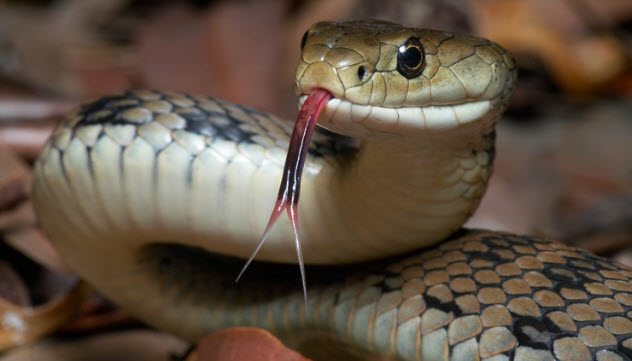
As if these reptiles were not threatening enough, snakes have holes in their heads called pit organs. These pits allow them to detect infrared radiation emitted from warm bodies up to 1 meter (3.3 ft) away. Infrared vision acts as an extra sense, providing information about prey in the dark and assisting in accurately striking the target.
The somatosensory system, of which the pit organ is a part, does not use eyes to receive signals. Snakes detect heat rather than see light photons. The same system is responsible for detecting pain, touch, and temperature.[6]
Pit membrane tissue is heated up by infrared radiation. When the tissue reaches a threshold temperature, an electrical signal is triggered by ions flowing into the snake’s nerve cells.
According to observations, the threshold temperature for some snakes is just above 28 degrees Celsius (82 °F), which is similar to the temperature emitted from a squirrel or mouse roughly 1 meter (3.3 ft) away. Pits in the head of a snake are also a great indicator of whether it is venomous, as other snakes do not have them.
4 Pigs
 Pigs are yet another animal with an impressive sense of smell. They are commonly used to find one of the most expensive foods—truffles. Researchers have figured out why pigs are so good at finding this fungus. Truffles contain large amounts of a substance that is also synthesized in boar testicles.
Pigs are yet another animal with an impressive sense of smell. They are commonly used to find one of the most expensive foods—truffles. Researchers have figured out why pigs are so good at finding this fungus. Truffles contain large amounts of a substance that is also synthesized in boar testicles.
The substance is secreted in the saliva of boars looking to breed. Females are attracted to the musky scent emanating from their saliva foam. Hopes of mating are enough incentive for pigs to detect the fungus up to 1 meter (3 ft) below ground.
The same substance is produced by the testicles of human males and is secreted through their sweat glands. The urine of women also contains some of the same chemicals. This might help to explain why people enjoy truffles and are willing to pay so much for them.
Italian laws have forbidden the use of pigs to find truffles since 1985. Truffles are highly sensitive to changes in the environment, and pigs destroy it by carelessly scraping the ground. The ecosystem necessary for the growth of truffles is very fragile and can be disturbed by moving a single stone.
Pigs also frequently end up eating the truffles they find. As a result, dogs are more commonly used for the search nowadays. However, dogs require training and still cannot rival the truffle detection abilities of a pig.
Pigs continue to be used for this purpose in other countries.[7]
3 Fish
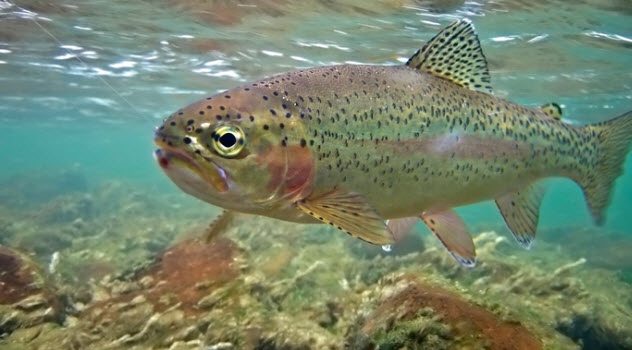
Sunlight is scarce at the depths of most water sources, and eyesight is not reliable below the 200-meter (656 ft) mark. Meanwhile, fish do not seem to struggle with avoiding obstacles and whirlpools, keeping up with water flow, or tracking prey.
Flow sensors were identified on the surfaces of nearly all species of fish. The sensor network helps in gathering information about the flow of water. Researchers put their efforts into studying the sensory organ system of fish. This system detects vibrations and movement in surrounding water. Another point of focus was canals, which open via several pores.
After subjecting a rainbow trout fish model to realistic aquatic conditions, concluding results showed great importance in the locations of the canal system. They could be found on top of the head and in other areas where strong pressure variation occurs.[8]
2 Elephants
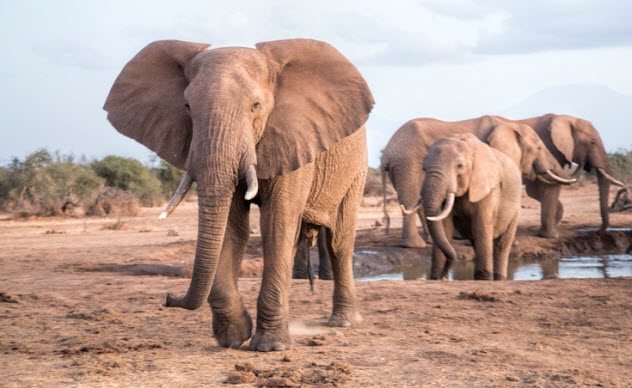
With a set of ears that large, elephants obviously have an incredible sense of hearing. Although they have been seen suddenly changing their direction for no clear reason, this is no longer a mystery. Studies have revealed that elephants are capable of detecting a rainstorm approaching from roughly 241 kilometers (150 miles) away.[9]
This uncanny ability was uncovered by analyzing the migrations of elephants in Namibia. The large beasts can hear frequencies below the range of hearing that humans possess and use this as one of their ways of communication. Similar low-frequency sound is produced by thunderstorms.
After seven years of tracking the movements of nine elephants from different herds with GPS, researchers found evidence that suggested changes in the elephants’ course during the region’s rainy season. Researchers observed their movement toward thunderstorms hundreds of miles off, days before rain occurred.
Knowing when, where, and why they move may help conservation efforts as 100,000 African elephants were killed by poachers between 2010 and 2012 alone.
1 Dogs

Obviously, when talking about animal detection powers, you have to bring up dogs. Although rats or pigs may have a better sense of smell in some areas, nothing can beat the relationship between a man and his best friend. Being loyal and easy to train, dogs are the perfect candidates for any situation that calls for the superior senses of animals.
Medical detection dogs use their noses to find illness in people. Detecting odor concentrations as little as one part per trillion allows them to sense the smell created by diseases. This can be compared to detecting a teaspoon of sugar dissolved in two Olympic swimming pools.
Canines outmatch our feline friends in this area as dogs are capable of sensing cancer—something cats cannot accomplish. Unique odors emitted by cancerous cells allow dogs to alert people to disease faster than doctors can.
A case was reported where a dog kept sniffing the lesion on the owner’s thigh. The animal even attempted to bite off the lesion, which was later confirmed to be a malignant melanoma. The dog may have saved its owner’s life by detecting the cancer at an early and curable stage.[10]
Seems like dolphins aren’t the only animals with pregnancy detection abilities, either. Dogs appear to behave differently around pregnant women. Experts believe that the canines can smell hormonal changes in women at that time.
Dogs are known to be highly sensitive to changes in the mood and behavior of human beings. Noticing these changes in pregnant women can make the animals more attentive and protective. Dogs might even be able to hear the infant’s heartbeat, although this is hard to prove scientifically.
Hunting for truffles is another skill that our four-legged friends can acquire through a few months of training. They do not have as much motivation to find the fungus as pigs, but the dogs’ precision makes up for it.
Dogs find the exact location of a truffle rather than destroy the environment by scraping everywhere around it. They do not eat the truffles upon finding them and are definitely less conspicuous than pigs when taken out for a walk. These qualities have resulted in dogs being used more commonly for the activity.
Explosives are another item on the list of things frequently detected by canines. Handlers are usually alerted by the dogs sitting down once explosive substances are found.
Similarly, they are used for drug searches. Although the accuracy of drug detection dogs is sometimes questioned, it is usually due to them sensing very small amounts of the chemicals. Their ability to find traces of drugs too small for the naked eye is often mistaken as “false positives” by critics.
Seems like our loyal companions will remain the kings of detection because a few months of training is all they need to find just about anything.
Erich is a fan of trivia and unique facts.
Read about more ways that animals are superior to man on 10 Amazing Ways Animals Are Superior To Man and 10 Technological Advances That Animals Had First.







